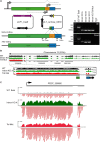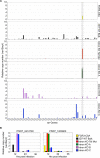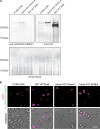CRISPR/Cas9 Genome Editing Reveals That the Intron Is Not Essential for var2csa Gene Activation or Silencing in Plasmodium falciparum
- PMID: 28698275
- PMCID: PMC5513710
- DOI: 10.1128/mBio.00729-17
CRISPR/Cas9 Genome Editing Reveals That the Intron Is Not Essential for var2csa Gene Activation or Silencing in Plasmodium falciparum
Abstract
Plasmodium falciparum relies on monoallelic expression of 1 of 60 var virulence genes for antigenic variation and host immune evasion. Each var gene contains a conserved intron which has been implicated in previous studies in both activation and repression of transcription via several epigenetic mechanisms, including interaction with the var promoter, production of long noncoding RNAs (lncRNAs), and localization to repressive perinuclear sites. However, functional studies have relied primarily on artificial expression constructs. Using the recently developed P. falciparum clustered regularly interspaced short palindromic repeats (CRISPR)/Cas9 system, we directly deleted the var2csa P. falciparum 3D7_1200600 (Pf3D7_1200600) endogenous intron, resulting in an intronless var gene in a natural, marker-free chromosomal context. Deletion of the var2csa intron resulted in an upregulation of transcription of the var2csa gene in ring-stage parasites and subsequent expression of the PfEMP1 protein in late-stage parasites. Intron deletion did not affect the normal temporal regulation and subsequent transcriptional silencing of the var gene in trophozoites but did result in increased rates of var gene switching in some mutant clones. Transcriptional repression of the intronless var2csa gene could be achieved via long-term culture or panning with the CD36 receptor, after which reactivation was possible with chondroitin sulfate A (CSA) panning. These data suggest that the var2csa intron is not required for silencing or activation in ring-stage parasites but point to a subtle role in regulation of switching within the var gene family.IMPORTANCEPlasmodium falciparum is the most virulent species of malaria parasite, causing high rates of morbidity and mortality in those infected. Chronic infection depends on an immune evasion mechanism termed antigenic variation, which in turn relies on monoallelic expression of 1 of ~60 var genes. Understanding antigenic variation and the transcriptional regulation of monoallelic expression is important for developing drugs and/or vaccines. The var gene family encodes the antigenic surface proteins that decorate infected erythrocytes. Until recently, studying the underlying genetic elements that regulate monoallelic expression in P. falciparum was difficult, and most studies relied on artificial systems such as episomal reporter genes. Our study was the first to use CRISPR/Cas9 genome editing for the functional study of an important, conserved genetic element of var genes-the intron-in an endogenous, episome-free manner. Our findings shed light on the role of the var gene intron in transcriptional regulation of monoallelic expression.
Keywords: CRISPR/Cas9; Plasmodium falciparum; antigenic variation; transcriptional regulation; var genes.
Copyright © 2017 Bryant et al.
Figures




Similar articles
-
CRISPR Interference of a Clonally Variant GC-Rich Noncoding RNA Family Leads to General Repression of var Genes in Plasmodium falciparum.mBio. 2020 Jan 21;11(1):e03054-19. doi: 10.1128/mBio.03054-19. mBio. 2020. PMID: 31964736 Free PMC article.
-
A Unique Virulence Gene Occupies a Principal Position in Immune Evasion by the Malaria Parasite Plasmodium falciparum.PLoS Genet. 2015 May 19;11(5):e1005234. doi: 10.1371/journal.pgen.1005234. eCollection 2015 May. PLoS Genet. 2015. PMID: 25993442 Free PMC article.
-
The Plasmodium falciparum histone methyltransferase PfSET10 is dispensable for the regulation of antigenic variation and gene expression in blood-stage parasites.mSphere. 2024 Nov 21;9(11):e0054624. doi: 10.1128/msphere.00546-24. Epub 2024 Oct 24. mSphere. 2024. PMID: 39445826 Free PMC article.
-
Antigenic variation in Plasmodium falciparum.Annu Rev Microbiol. 2008;62:445-70. doi: 10.1146/annurev.micro.61.080706.093134. Annu Rev Microbiol. 2008. PMID: 18785843 Review.
-
The epigenetic control of antigenic variation in Plasmodium falciparum.Curr Opin Microbiol. 2005 Aug;8(4):434-40. doi: 10.1016/j.mib.2005.06.007. Curr Opin Microbiol. 2005. PMID: 15979386 Review.
Cited by
-
Cutting back malaria: CRISPR/Cas9 genome editing of Plasmodium.Brief Funct Genomics. 2019 Sep 24;18(5):281-289. doi: 10.1093/bfgp/elz012. Brief Funct Genomics. 2019. PMID: 31365053 Free PMC article. Review.
-
CRISPR Interference of a Clonally Variant GC-Rich Noncoding RNA Family Leads to General Repression of var Genes in Plasmodium falciparum.mBio. 2020 Jan 21;11(1):e03054-19. doi: 10.1128/mBio.03054-19. mBio. 2020. PMID: 31964736 Free PMC article.
-
The dCas9-based genome editing in Plasmodium yoelii.mSphere. 2024 Mar 26;9(3):e0009524. doi: 10.1128/msphere.00095-24. Epub 2024 Feb 27. mSphere. 2024. PMID: 38411120 Free PMC article.
-
Noncoding RNAs in Apicomplexan Parasites: An Update.Trends Parasitol. 2020 Oct;36(10):835-849. doi: 10.1016/j.pt.2020.07.006. Epub 2020 Aug 20. Trends Parasitol. 2020. PMID: 32828659 Free PMC article. Review.
-
Discovery of RUF6 ncRNA-interacting proteins involved in P. falciparum immune evasion.Life Sci Alliance. 2022 Nov 15;6(1):e202201577. doi: 10.26508/lsa.202201577. Print 2023 Jan. Life Sci Alliance. 2022. PMID: 36379669 Free PMC article.
References
-
- Jiang L, Mu J, Zhang Q, Ni T, Srinivasan P, Rayavara K, Yang W, Turner L, Lavstsen T, Theander TG, Peng W, Wei G, Jing Q, Wakabayashi Y, Bansal A, Luo Y, Ribeiro JM, Scherf A, Aravind L, Zhu J, Zhao K, Miller LH. 2013. PfSETvs methylation of histone H3K36 represses virulence genes in Plasmodium falciparum. Nature 499:223–227. doi:10.1038/nature12361. - DOI - PMC - PubMed
-
- Lopez-Rubio JJ, Gontijo AM, Nunes MC, Issar N, Hernandez Rivas R, Scherf A. 2007. 5’ flanking region of var genes nucleate histone modification patterns linked to phenotypic inheritance of virulence traits in malaria parasites. Mol Microbiol 66:1296–1305. doi:10.1111/j.1365-2958.2007.06009.x. - DOI - PMC - PubMed
Publication types
MeSH terms
Substances
LinkOut - more resources
Full Text Sources
Other Literature Sources

